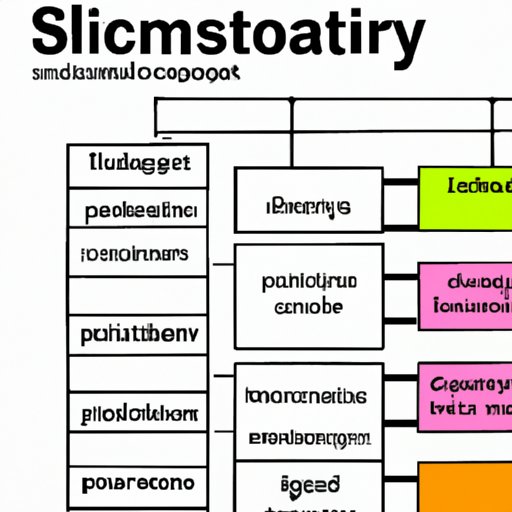Introduction
Taxonomy is a branch of science that deals with the classification, naming, and identification of living things. It is an important tool for understanding the diversity of life on Earth and has a wide range of applications in fields such as medicine, ecology, and conservation. This article will explore the science of classifying organisms, from its history and development to its different systems and uses in the field.
Exploring the History and Development of Taxonomy
Taxonomy has been around since ancient times, but it was not until the 18th century that the discipline began to take shape. In 1735, Swedish naturalist Carl Linnaeus published his book Systema Naturae, which established the groundwork for modern taxonomy. His system was based on the principle of binomial nomenclature, which assigns two-part Latin names to species. This system is still used today.
In the 19th century, Charles Darwin’s theory of evolution revolutionized our understanding of the natural world. His work prompted further advances in taxonomy, such as the development of phylogenetics, or the study of evolutionary relationships between organisms. This gave rise to a new system of classifying organisms known as the phylogenetic system, which is based on evolutionary relationships rather than physical characteristics.
An Overview of the Science of Classifying Organisms
Taxonomy is the science of classifying organisms. It involves assigning each organism to a particular group or taxon based on shared characteristics. Taxonomy helps us understand the relationships between organisms and provides a way of organizing them into meaningful categories. It also allows us to identify unknown species.
Organisms are classified according to a hierarchical system of categories, from the most general to the most specific. At the top of this hierarchy is the domain, which is divided into three groups: bacteria, archaea, and eukaryota. Eukaryota is further divided into kingdoms, phyla, classes, orders, families, genera, and species. Each of these categories is based on shared characteristics that define the group.
Examining the Different Systems of Taxonomy
The two main systems of taxonomy are the Linnaean system and the phylogenetic system. The Linnaean system is the traditional system of classification developed by Carl Linnaeus. It is based on physical characteristics and is used to classify organisms according to their morphological similarities. This system is still used today, although it has been modified over time to incorporate more information about evolutionary relationships.
The phylogenetic system is a newer system of classification based on evolutionary relationships. It uses molecular data such as DNA sequences to create a “family tree” of related organisms. This system is becoming increasingly popular as it provides more accurate and detailed information about the evolutionary history of organisms than the Linnaean system.

Analyzing the Role of Taxonomists in the Field
Taxonomists are scientists who specialize in the classification and identification of organisms. They use the principles of taxonomy to organize and classify organisms according to their characteristics. Taxonomists often work in museums, universities, government agencies, and private companies.
The primary responsibility of a taxonomist is to identify, name, and classify organisms. They also play a key role in research projects involving the study of biodiversity and conservation. Taxonomists may also be involved in the cataloging and description of new species.

Investigating the Different Uses of Taxonomy
Taxonomy has many practical applications in the real world. One of the most important uses is in the identification of species. Taxonomic identification is essential for monitoring species populations and preventing the spread of invasive species. It is also used in environmental monitoring, such as water quality testing and wildlife surveys.
Taxonomy is also used in conservation efforts. Knowing the identity and distribution of species is essential for protecting them from extinction. Taxonomy can also help us understand how species interact with each other and their environment, which can be used to develop conservation strategies.

Comparing Taxonomic Classification to Other Organizational Systems
Taxonomic classification can be compared to other organizational systems, such as scientific nomenclature and library catalogs. Scientific nomenclature is a system of names used to classify organisms, while library catalogs are used to organize books and other materials. Both systems use a hierarchical structure to organize information and make it easier to find what you are looking for.
Taxonomic classification is similar to both systems in that it uses a hierarchical structure to organize information. However, it differs in that it is based on evolutionary relationships rather than physical characteristics or subject matter. This makes it a powerful tool for understanding the diversity of life on Earth.
Conclusion
Taxonomy is the science of classifying organisms. It has a long history and has evolved over time to incorporate modern theories such as Darwin’s theory of evolution. Taxonomy involves assigning organisms to particular groups or taxa based on shared characteristics, and there are two main systems of classification: the Linnaean system and the phylogenetic system. Taxonomists play a key role in the field, and taxonomy has many practical applications, such as in the identification of species and in conservation efforts.
Taxonomic classification can be compared to other organizational systems, such as scientific nomenclature and library catalogs. All of these systems use a hierarchical structure to organize information and make it easier to find what you are looking for. Taxonomy is an invaluable tool for understanding the diversity of life on Earth and has many uses in the real world.
(Note: Is this article not meeting your expectations? Do you have knowledge or insights to share? Unlock new opportunities and expand your reach by joining our authors team. Click Registration to join us and share your expertise with our readers.)
